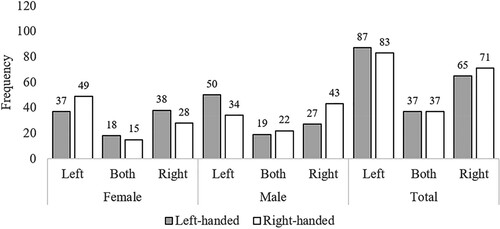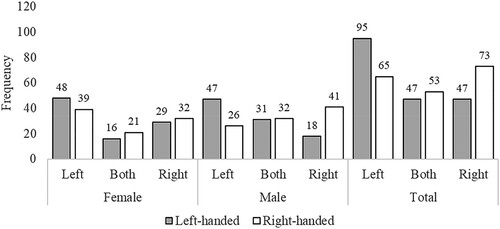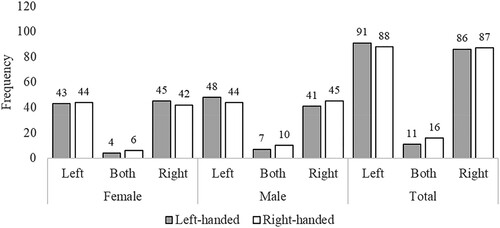Figures & data
Figure 1. Images used to elicit side preferences. Note: The three images in panels a, b, and c were presented sequentially, each with their own side preference question: (a) Walking; (b) Bench; and (c) Bed. Scores for panel c (Bed) were reversed for analysis.

Table 1. Laterality quotients for the modified Edinburgh handedness inventory.
Table 2. Model selection table for Study 2.
Figure 2. Study 2 (Survey): Preferred walking side data. Note: Frequencies (raw counts) for preferred walking side as a function of Sex and Handedness. Side is the side from the walker’s perspective (e.g., “Left” means the participant preferred to be on the left of their partner when walking). “Both” indicates the participants chose “Both sides equally”.

Figure 3. Study 2 (Survey): Preferred bench sitting side data. Note: Frequencies (raw counts) for preferred side when sitting on a bench as a function of Sex and Handedness. Side is the side from the sitter’s perspective (e.g., “Left” means the participant preferred to be on the left of their partner when sitting on a bench). “Both” indicates that the participants chose “Both sides equally”.

Figure 4. Study 2 (Survey): Preferred side when lying on a bed. Note: Frequencies (raw counts) for preferred side when lying on a bed as a function of Sex and Handedness. Side is the side of the bed from the perspective of the participant in relation to their partner when both are lying on their backs (e.g., “Left” means the participant preferred to be on the left of their partner when they are both lying in bed on their backs). “Both” indicates that the participants chose “Both sides equally”.

Table 3. Final (maximal) generalized mixed model for Study 2.
Data availability statement
Supplemental data for this manuscript can be accessed at: https://doi.org/10.6084/m9.figshare.20057021.v1.
